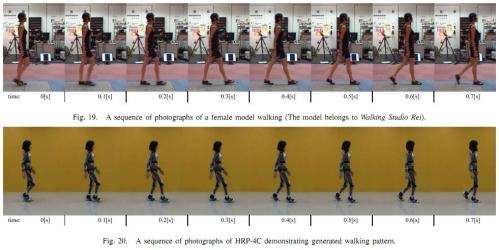November 13, 2011 report
HRP-4C female robot has a new walk (w/ video)

(PhysOrg.com) -- Japan's entertaining robot that sings and looks like a beautiful young female is finally learning how to walk just like a beautiful girl—well, almost. Robotics developers at the National Institute of Advanced Industrial Science and Technology (AIST) have released a video of their HRP-4C “Miim robot” to show how it can walk better than before.
HRP-4C has 30 motors in its body that allow it to walk and move its arms; and eight motors on its face to create human expressions. The robot is based on User Centered Robot Open Architecture utilizing fundamental robotic technologies including real-time Linux, RT middleware, robot simulator openHRP3, and speech recognition.
AIST researchers, like other scientific groups dedicated to robotics, have been working hard to create the “perfect” walking robot and to design walking technologies that can make their robots most closely resemble the way humans walk.
This has not been easy. Developing a robot to walk like a human has been a challenge for engineers, but that has only motivated more work toward this end in robotics.
The AIST researchers focused on a few key areas of the robot to improve results. The robot’s toes now support the legs better during each stride, and the legs straighten out more.
Details about how they got “Miim” to walk in a more human fashion than in previous iterations are in the paper, “Human-Like Walking with Toe Supporting for Humanoids,” by Kanako Miura, Mitsuharu Morisawa, Fumio Kanehiro, Shuuji Kajita, Kenji Kaneko, and Kazuhito Yokoi.
The authors explain that in working up a model of a walking pattern imitating human motion their focus was placed on three characteristics of walking: single toe support, knee stretching, and swing leg motion.
Based on a conventional pattern generator, the researchers added single toe support, changed the robot’s waist height to stretch the knees as much as possible, and sought to generate a swing leg motion more closely approximating a human's motion.
Curiously, while some tech sites have highly praised the team for having succeeded in making HRP-4C “Miim” walk like a human being, the video showing Miim walking resembles a woman who has just been released from a long stay in hospital from suffering broken bones and must learn to walk normally again in broad daylight without crutches.
Still, Miim’s new walking abilities are a step up, less mechanical than before. At the least, this is seen as a promising building block upon which to improve in the coming months and years.
HRP-4C was devised as a female humanoid robot for entertainment events. It was designed to have a realistic-looking face and to carry measurements reflecting the average figure of a young Japanese female. The robot was first shown to the public in March 2009.
Elsewhere, Boston Dynamics has been hard at work to perfect the walking movements of human-like robots. Its recent news about walking robots focuses on PETMAN, which the company claims is “the first anthropomorphic robot that moves dynamically like a real person.”
More information: Human-like walking with toe supporting for humanoids, This paper appears in: Intelligent Robots and Systems (IROS), 2011 IEEE/RSJ International Conference on Issue Date: 25-30 Sept. 2011 On page(s): 4428 - 4435 Location: San Francisco, CA, USA ISSN: 2153-0858 DOI:10.1109/IROS.2011.6048511 (PDF available)
ABSTRACT
A model of a walking pattern imitating human motion is presented. An accurate imitation of human motion and a robust bipedal walking motion are, however, hardly realized together. We therefore focus on only three characteristics of human walking motion: single toe support, knee stretching, and swing leg motion. Based on a conventional pattern generator, single toe support is added, waist height is changed in order to stretch the knees as much as possible, and swing leg motion is generated approximating the human's motion. The generated motion is then filtered to provide a feasible pattern. In addition, the stabilizer is improved in order to keep the Zero Moment Point (ZMP) within the tiny support polygon during the single support phase with toe link. Finally, we successfully demonstrate the generated walking pattern with the robot HRP-4C.
© 2011 PhysOrg.com




















